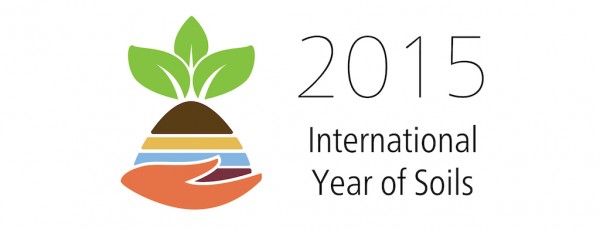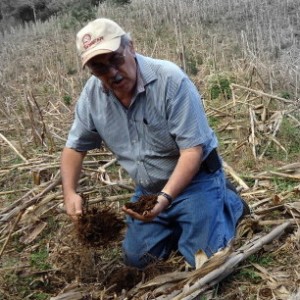
2015 is the International Year of Soils, according to a declaration from the 68th UN General Assembly.
by Hugh Aprile of CRS Coffeelands Blog
In my last post, as part of a tribute to the International Year of Soils, I promised to seek out experts in the area of soil management and coffee production and to share their invaluable insights. Fortunately, I didn’t have to look far. My colleague, Luis Álvarez Welchez, knows soil and coffee. Luis has dedicated his decades-long career with the United Nations Food and Agriculture Organization (FAO), and more recently with Catholic Relief Services (CRS), to improving the livelihoods of smallholder farmers in his native country of Honduras and throughout Central America.
Despite living and working during an era of increased emphasis on synthetic fertilizer and genetic answers to agricultural productivity problems, Luis has never swayed in his firm belief that only a more holistic approach to addressing these issues will result in viable long-term solutions. According to Luis, we must respect and protect the delicate soil systems that nourish plants.
I should add that Luis is also a smallholder coffee producer. Luis only preaches what he himself puts into practice.
How important is the management of soil health for the production of a coffee plant?
It is very important because soil is the primary system from which the plant lives and absorbs water and critical nutrients such as nitrogen, phosphorous, potassium, calcium, magnesium, etc. When the soil system is managed properly it can also help to maintain the moisture level needed to give the coffee plant the water it needs. This is especially important during dry spells.
If soil is well managed — in other words, if farmers make sure that their soils receive the requisite amounts of organic matter, moisture, sunlight, aeration, nutrients, vegetative cover, etc. — then the soil on their farms will achieve the proper balance of physical, chemical and biological properties that help to ensure the overall health of plants.
You have to think of soil as a balanced system. If you remove more than what you put in it (i.e. do not replace nutrients with fertilizer), then the system will collapse. That’s why Integrated Soil Fertility Management is so essential to the health of the plant. The fertility of the soil is its capacity to provide nutrients to plants. High fertility translates into healthy coffee plants and higher yields, that is, as long as there is enough water in the soil as well.
In order for a coffee plant to produce 100 pounds of green coffee (1 quintal) it must extract from the soil approximately 1.45 kg of nitrogen, 0.28 kg of phosphorous, and 1.74 kg of potassium. And that’s just what it needs to produce coffee beans. The plant needs even more nutrients from the soil in order to support overall plant growth and maintenance and to become more tolerant of diseases, pests and moderate changes in weather.
A coffee plant is like a person, if properly nourished it will thrive.
Based on your experience, what is the level of knowledge of a small coffee producer in Central America regarding the management of soil for coffee?
Farmers in Central America have learned to manage some aspects of soil management in seedbeds and plant nurseries and even to some degree how to prepare soil at planting. After that point, however, most farmers simply don’t know how to manage soil well enough to ensure productive farms. For example, they don’t know how to control soil acidity and neutralize the aluminum that is overabundant in soil of coffee farms in this region.
Not having received much if any training in proper soil management, coffee farmers tend to apply fertilizers incorrectly, without doing soil testing to determine pH and existing nutrient content and without evaluating recommended amounts of fertilizer blends on their farms.
Honduras made progress in the area of soil management from about 1985 to 1995, but then investments in research and extension services dried up to the detriment of small farmers. In Honduras, as in the rest of Central America, agricultural research, and soil management in particular, is only now re-emerging as a priority.
Can you tell us more about the reasons behind the lack of knowledge among coffee farmers regarding proper soil management?
Soil has been the forgotten natural resource at the heart of farming, especially among coffee farmers who have never really benefitted from an effective extension and training system.
What our countries have lacked over the last few years is an institutional handover from one generation to the next in terms of research in soil quality and evaluation of technologies focused on plant nutrition. Instead, the impetus has been geared more toward genetics and other green revolution-oriented solutions. Don’t get me wrong, advances in plant genetics have been very important, but we need to place a similar weight on the importance of plant nutrition, soil organic matter and management of acidity where pH is low enough to cause aluminum toxicity and deficiencies of critical nutrients for coffee production, such as phosphorus, calcium and magnesium.
One of the greatest victims of the lack of investment in proper soil management has been organic coffee production, which in many cases has failed because farmers simply haven’t had the knowledge and tools to ensure that their coffee plants were sufficiently nourished by their soil.
I would also say that this lack of knowledge regarding soil management isn’t only about farmers. Technical staff (e.g., extension workers) also lack sufficient understanding of proper soil management, and as a result they are unable to transfer the necessary knowledge and skills to producers. And then there is the problem that there are too few coffee technicians to attend to the demand of coffee farmers to begin with.
If you had to choose one improved practice related to soil management to share with a small coffee producer, what would it be and why?
Where coffee is grown in acidic soils, the practice I most recommend is to control acidity in order to control levels of soluble aluminum and to reduce associated nutrient deficiencies, especially of phosphorus. Central American soils with low pH (high acidity) tend to be low in phosphorus, which is critical to root development. So by controlling soil acidity you are promoting healthy root systems, which in turn support production of plant biomass and ultimately coffee productivity.
Raising soil pH to reduce its acidity also enhances the absorption of other essential nutrients that nourish plants, help coffee productivity and improve bean quality.
Is it possible to improve coffee quality (flavor profile) with good soil management?
Yes, of course. Coffee quality depends on a combination of the right balance of nutrients found in the soil and a plant’s altitude. The plant’s health, determined by how well it is nourished through the soil, has a direct effect on the coffee’s body, flavor and aroma. Higher altitudes, and cooler temperatures, lead to slower photosynthesis that allows plants to metabolize nutrients more gradually and hence produce bigger and better beans.
What is the role of soil management in the fight against coffee leaf rust and other epidemics?
There is a direct relationship between soil acidity and the proliferation of fungi and other diseases such as coffee leaf rust, so for me, managing soil pH is particularly important in the fight against diseases.
Timing is also critical. Farmers often forget that they must ensure that their coffee plants are well nourished through proper soil management immediately after the harvest. What is particularly important here is that plants receive sufficient nitrogen and potassium to help ensure the replacement of harvested biomass (plant tissue and leaves) during production and harvest.
Other soil nutrients such as copper, sulfur and zinc also act as natural deterrents to coffee diseases and reduce vulnerability to pests.
Is there anything else you would like to explain or express to our readers?
Yes, first, I’d like to add that the sustainability of coffee production must include a systemic approach from production all the way to the market. This means that we can’t forget focusing on the capacity of smallholder farmers at the local level to manage every step of the value chain.
Second, I would say that to mitigate changes in climate in coffee growing areas it is essential that we make serious investments in research related to Integrated Soil Fertility Management, as well as better water management through improved soil management.
And finally, let’s not forget to diversify our coffee farms! Sometimes the best way to ensure the viability of our smallholder farmers is to make sure they can count on income from several sources.
Hugh Aprile
Hugh Aprile is the CRS Director for Regional Agriculture and Water Initiatives for Central America. He is based in Managua.







Comment